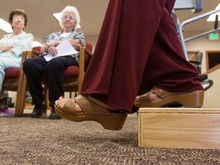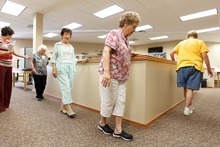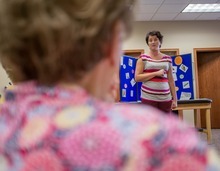This is an archived article that was published on sltrib.com in 2012, and information in the article may be outdated. It is provided only for personal research purposes and may not be reprinted.
CLEARFIELD • Amanda Thompson has fallen to teach the class of mostly octogenarians how to get up.
The physical therapist tells them to calm themselves "before you jump up and go."
Bonnie Middleton leans over in her chair to the prone Thompson and lets her in on a senior-citizen secret. "We don't jump up and go!" the 84-year-old says with a laugh.
She's the class cut up — when asked earlier what they should do if they don't have a cane to step off a curb, Bonnie quipped, "Pray" — but she takes the lessons seriously.
"When you're 84, you don't do things you used to do without some concern. If I fall and can't take care of myself, it's going to be a whole different life for me, so I've got to prevent it."
That's a common concern among the five seniors in the class: If they fall, and some already have, they fear it's the beginning of the end.
And for good reason: Falls are the leading cause of death and injury disability among Utahns 65 and older, with more than one-third of that population falling each year.
Those falls lead to almost 6,500 emergency room visits, 3,000 hospitalizations and 89 deaths a year, according to the Utah Department of Health.
When the falls result in a traumatic brain injury and a trip to the hospital — and that happens 510 times a year in Utah — half of the patients don't return home; they instead need rehabilitation or go to a long-term care facility.
—
'A huge toll' • The aging process makes falls more likely: Eyesight, hearing, muscle strength, coordination and reflexes deteriorate. And balance is thrown off by diabetes, heart disease or other problems.
"This is a very devastating and frequent occurrence in older adults," says Nanci McLeskey, who teaches nursing students at the University of Utah about how to care for the elderly. But falling is not inevitable, she adds.
Utah may have the nation's youngest population, but its senior population is rapidly growing and living longer. They are also hospitalized for falls at a greater rate than their national peers.
The state health department focused on this costly issue — inpatient hospital charges topped $135 million in 2010 — creating the Utah Falls Prevention Coalition last year.
Made up of public health officials, geriatricians and hospital officials, it plans to boost efforts to screen seniors for their fall risk and train more health care providers on how to prevent falls.
"It just hasn't been a priority for our state, but it takes such a huge toll on a segment of our population so we really needed to focus in on that," said Jenny Johnson, spokeswoman for the health department's Violence and Injury Prevention Program.
—
Stepping on • The coalition has already spurred a handful of local health departments to offer strength and mobility classes to seniors, like the one in Clearfield.
On a recent day, the class led by Thompson and educators from the Davis County Health Department reviewed exercises such as heel and toe raises. The women lined up at a ledge and kicked their legs out like ballerinas.
Thompson took them through moves they've taken for granted but need to practice in their aging bodies: how to sit (back up to the chair, feel it with their legs, look behind them and lower down slowly) stand up (scoot to the edge of the chair, lean forward and push up with hands if needed), walk (heel first, wide stance, scan ahead).
"It's good to know whether you're doing it right," said Nola Toole, an 83-year-old from Sunset, who fell a couple of years ago and says she wobbles as she walks. "Now you have to think about everything you do.... I've always heard if you break your hip, that's the beginning of the end."
Through the seven-week course, they also learn how to identify hazards in their homes, such as throw rugs and stairs without rails, and medications that increase their chances of falling, such as drugs for high blood pressure and pain pills.
Called "Stepping On," it's one of 22 programs lauded by the Centers for Disease Control and Prevention as effective. Studies have shown it cuts fall risk by 30 percent and even up to 45 percent among seniors still living in their homes.
Carrie Bennett, injury prevention program coordinator with the Utah County Department of Health, trains officials in Utah on how to teach the classes. She said it emphasizes empowering seniors to "come to their own conclusions [that], 'I can make this change. I can become stronger and have better control of my balance.'"
She has a waiting list of 80 seniors who would like to take the class, about double the number who finished the course in Utah County. Statewide, about 140 seniors have attended.
Bennett has trained officials in Davis, Salt Lake Valley, Summit, Wasatch and Southeastern health departments, though not all of them have offered the classes yet. "Seniors just love it. We have tons of people waiting, just not enough funding to do too many classes in a year," she said.
—
'You can help' • While falls can lead to a trip to the hospital, they can also happen inside the hospital. Those preventable medical errors are considered hospital-acquired conditions — so hospitals can't charge the patient or Medicare (along with many other insurance plans) to cover the costs.
According to Centers for Medicare and Medicaid Services, falls are one of the top hospital-acquired conditions, with 260,000 reported in 2010, behind adverse drug events, catheter-associated urinary tract infections and pressure ulcers.
Utah data shows patients ages 50 and older are at the highest risk for falling in hospitals for the same reasons they fall in their homes. Hospitals voluntarily reported 22 falls among that age group from 2007 to 2011.
"Falls are a common thing," said Marlyn Conti, patient safety coordinator for Intermountain Healthcare and a member of the state falls coalition. "You bring people into an unfamiliar environment. You give them medications. You take them into surgery. They've had anesthesia."
She said her hospital system has reduced falls through steps such as assessing patients' risk: whether they are older, have fallen in the past three months, are on certain medications or have had recent surgery. As at other hospitals, Intermountain staff are alerted to at-risk patients by a sticker on the door or a wristband, and the beds have alarms that sound when patients try to get up on their own.
Patients and their families are also given information about how to avoid falls. The University of Utah found it works even better if asks orthopedic patients sign agreements that they will call for help if they need to get out of bed or get an object.
Students in the U.'s nursing college added a gerontology clinical rotation this year to teach students about how to care for the elderly, which includes fall prevention. Students teach exercise classes at assisted living centers and are trained on how to watch patients walk to see if they need to be assessed for fall risk, said the U.'s McLeskey.
"You can't stop older adults from falling completely," she said. "But you can help and prevent the injuries that occur and also minimize those risks."
Reducing the risks
Who's at risk of falling?
Risk factors include being older, having poor eyesight, a lack of regular exercise, poor nutrition, certain medications that cause drowsiness or dizziness, and having osteoporosis, arthritis, clinical depression, dementia-related and neurological or musculoskeletal disorders such as Parkinson's and Alzheimer's disease, according to the Utah Department of Health.
How can risks be reduced at home?
Remove throw rugs, cords and clutter from the floor.
Tack down or tape carpet edges.
Don't walk in socks, stockings or slippers and wear low-heeled shoes.
Clear pathways of furniture and electrical cords.
Improve lighting with night lights, lamps, well-lit stairwells.
Install handrails in bathrooms for bathing and toilet use.
Use nonslip mats in the bathtub and shower.
Limit reaching or bending by storing commonly used items on lower shelves or countertops and avoid step stools.
Ensure telephones are accessible.
Source: Intermountain Healthcare, National Institutes of Health Osteoporosis and Related Bone Disease National Resource Center —
If you fall
Prevent breaking a bone by trying to fall forwards or backwards onto your buttocks. Falling to the side may break your hip. Grab things around you to break a fall.
Source: National Institutes of Health Osteoporosis and Related Bone Disease National Resource Center. —
Exercise can improve balance
Here are some moves to try. While holding the back of a chair, sink or counter:
Stand on one leg at a time for a minute and then slowly increase the time. Try to balance with your eyes closed or without holding on.
Stand on your toes for a count of 10, and then rock back on your heels for a count of 10.
Make a big circle to the left with your hips, and then to the right. Do not move your shoulders or feet. Repeat five times.
Source: National Institutes of Health Osteoporosis and Related Bone Disease National Resource Center









